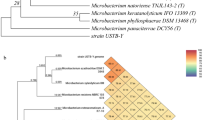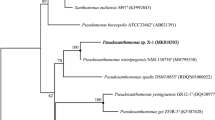Abstract
A gram-positive Microbacterium sp. strain, ITRC1, that was able to degrade the persistent and toxic hexachlorocyclohexane (HCH) isomers was isolated and characterized. The ITRC1 strain has the capacity to degrade all four major isomers of HCH present in both liquid cultures and aged contaminated soil. DNA fragments corresponding to the two initial genes involved in γ-HCH degradative pathway, encoding enzymes for γ-pentachlorocyclohexene hydrolytic dehalogenase (linB) and a 2,5-dichloro-2,5-cyclohexadiene-1,4-diol dehydrogenase (linC), were amplified by PCR and sequenced. Their presence in the ITRC1 genomic DNA was also confirmed by Southern hybridization. Sequencing of the amplified DNA fragment revealed that the two genes present in the ITRC1 strain were homologous to those present in Sphingomonas paucimobilis UT26. Both 16S rRNA sequencing and phylogenetic analysis resulted in the identification of the bacteria as a Microbacterium sp. We assume that these HCH-degrading bacteria evolved independently but possessed genes similar to S. paucimobilis UT26. The reported results indicate that catabolic genes for γ-HCH degradation are highly conserved in diverse genera of bacteria, including the gram-positive groups, occurring in various environmental conditions.





Similar content being viewed by others
References
Agnihotri NP, Kulshreshtha G, Gajbhiye VT, Mohapatra SP, Singh SB (1996) Organochlorine insecticidal residues in agricultural soils of the Indo-Gangetic plains. Environ Monit Assess 40:279–288
Ahuja R, Awasthi N, Manickam N, and Kumar A (2001) Metabolism 1,1-dichloro-2,2 bis(4-chlorophenyl) ethylene by Alcaligenes denitrificans. Biotechnol Lett 23:423–426
Altschul SF, Gish W, Miller W, Myers EW, Lipman DJ (1990) Basic local alignment search tool. J Mol Biol 215:403–410
ATSDR, Agency for toxic substances and disease registry, US Department of Health and Human Services (1999) Toxicological profile for alpha-, beta-, gamma-, and delta-hexachlorocyclohexane. Clement and Associates, Tauranga
Bachmann A, Walet P, Wijen P, De Bruin W, Huntjens JLM, Roelofsen W, Zehnder AJB (1988) Biodegradation of alpha and beta hexachlorocyclohexane in a soil slurry under different redox conditions. Appl Environ Microbiol 54:143–149
Bethesda Research Laboratories (1986) BRL pUC host: E. coli DH5α competent cells. Bethesda Res Lab Focus 8:9
Bergmann JG, Sainik J Jr (1957) Determination of trace amounts of chlorine in naptha. Anal Chem 29:241–243
Blais JM, Schindler DW, Muir DCG, Kimpe LE, Donald DB, Rosenberg B (1998) Accumulation of persistent organochlorine compounds in mountains of western Canada. Nature 395:585–588
Breivik K, Pacyna JM, Munch J (1999) Use of alpha-, beta- and gamma-hexachlorocyclohexane in Europe 1970–1996. Sci Total Environ 239:151–163
Boyle AW, Haggblöm MM, and Young LY (1999) Dehalogenation of lindane by anaerobic bacteria from marine sediments and by sulfate reducing bacteria. FEMS Microbiol Ecol 29:379–387
Deo PG, Karanth NG, Karanth NGK (1994) Biodegradation of hexachlorocyclohexane isomers in soil and food environment. Crit Rev Microbiol 20:57–78
Don RH, Cox PT, Wainwright BJ, Baker K, Mattick JS (1991) ‘Touchdown’ PCR to circumvent spurious priming during gene amplification. Nucleic Acids Res 19:4008
Donald DB, Syrgiannis J, Crosley, Holdsworth G, Muir DCG, Rosenberg B, Sole A, Schindler DW (1999) Delayed deposition of organochlorine pesticides at a temperate glacier. Environ Sci Technol 33:1794–1798
Eulberg D, Golovleva LA, Schlömann M (1997) Characterization of catechol catabolic genes from Rhodococcus erythropolis 1CP. J Bacteriol 179:370–383
Gupta A, Kausik CP, Kausik A (2000) Degradation of hexacholorocyclohexane (HCH; α, β, γ and δ) by Bacillus circulans and Bacillus brevis isolated from soil contaminated with HCH. Soil Biol Biochem 32:1803–1805
Imai R, Nagata Y, Fukuda M, Takagi M, Yano K (1991) Molecular cloning of a Pseudomonas paucimobilis gene encoding a 17-kilodalton polypeptide that eliminate HCl molecule from gamma hexachlorocyclohexane. J Bacteriol 173:6811–6819
Inoue H, Nojima H, Okayama H (1990) High efficiency transformation of Escherichia coli with plasmids. Gene 96:23–28
John PJ, Neela B, Bhatnagar P (2001) Assessment of organochlorine pesticide residue in dairy milk and buffalo milk from Jaipur City, Rajasthan, India. Environ Int 26:231–236
Kannan K, Tanabe S, Ramesh A, Subramanian A (1992) Persistent organochlorine residues in food from India and their implications on human dietary exposure. J Agric Food Chem 40:518–524
Kovacs MF (1965) Thin layer chromatography for pesticide residue analysis. J Assoc Off Agric Chem 48:1018–1022
Kumari R, Subudhi S, Suar M, Dhingra G, Raina V, Dogra C, Lal S, Meer van der JR, Holliger C, Lal R (2002) Cloning and characterization of lin genes responsible for the degradation of hexachlorocyclohexane isomers by Sphingomonas paucimobilis strain B90. Appl Environ Microbiol 68:6021–6028
Lane DJ (1991) 16S/23S rRNA sequencing. In: Stackebrandt E, Goodfellow M (eds) Nucleic acid techniques in bacterial systematics. Wiley, New York, pp 115–148
Li YF (1999) Global technical hexachlorocyclohexane usage and its contamination consequences in the environment: from 1948 to 1997. Sci Total Environ 232:121–158
Ludwig W, Strunk O, Westram R, Richter L, Meier H, Yadhukumar, Buchner A, Lai T, Steppi S, Jobb G, Foerster W, Brettske I, Gerber S, Ginhart AW, Gross O, Grumann S, Hermann S, Jost R, Koenig A, Liss T, Lussmann R, May M, Nonhoff B, Reichel B, Strehlow A, Stamatakis A, Stuckmann N, Vilbig A, Lenke M, Ludwig T, Bode A, Schleifer KH (2004) ARB: a software environment for sequence data. Nucleic Acids Res 32:1363–1371
Manickam N, Mau M, Schlömann M, Kumar A (2000) Cloning and characterization of genes for lindane degradation from a Microbacterium sp. Presented in the Annual Meeting of the German Association for General and Applied Microbiology 12–16 March, München, Germany
Marchuk D, Drumm M, Saulino A, Collins FS (1991) Construction of T-vectors; a rapid and general system for direct cloning of unmodified PCR products. Nucleic Acids Res 19:1154
Mathur HB, Johnson S, Singh B, Mishra R, Kumar A (2003) Bottled water has pesticide residues. Down Earth 11:27–33 http://www.cseindia.org/html/lab/bottled_water_result.htm
Meharg AA, Wright J, Leeks GJL, Wass PD, Osborn D (1999) Temporal and spatial patterns in α- and γ-hexachlorocyclohexane concentrations in industrially contaminated rivers. Environ Sci Technol 33:2001–2006
Nagasawa S, Kikuchi R, Nagata Y, Takagi M, Matsao M (1993) Aerobic mineralization of HCH by Pseudomonas paucimobilis UT26. Chemosphere 26:1719–1728
Nagata Y, Miyuchi M, Takagi M (1999) Complete analysis of genes and enzymes for γ-hexachlorocyclohexane degradation in Sphingomonas paucimobilis UT26. J Ind Microbiol Biotechnol 23:380–390
Nagata Y, Ohtomo R, Nariya T, Fukuda M, Yano K, Takagi M (1993) Cloning and sequencing of a dehalogenase gene encoding an enzyme with hydrolase activity involved in the degradation of gamma-hexachlorocyclohexane in Pseudomonas paucimobilis. J Bacteriol 175:6403–6410
Nagata Y, Ohtomo R, Miyauchi K, Fukuda M, Yano K, Takagi M (1994) Cloning and sequencing of a 2,5-dichloro-2,5-cyclohexadiene-1,4-diol dehydrogenase gene involved in the degradation of γ-hexachlorocyclohexane in Pseudomonas paucimobilis. J Bacteriol 176:3117–3125
Nalin R, Simonet P, Vogel TM, Normond P (1999) Rhodanobactor lindaniclasiticus gen. nov., sp. nov., a lindane-degrading bacterium. Int J Syst Bacteriol 49:19–23
Sahu SK, Patnaik KK, Sharmila M, Sethunathan N (1990) Degradation of alpha, beta and gamma-hexachlorocyclohexane by a soil bacterium under aerobic conditions. Appl Environ Microbiol 56:3620–3622
Sahu SK, Patnaik KK, Bhuyan S, Sethunathan N (1993) Degradation of soil-applied isomers of hexachlorocyclohexane by a Pseudomonas sp. Soil Biol Biochem 25:387–391
Saitou N, Nei M (1987) The neighbor-joining method; a new method for reconstructing phylogenetic trees. Mol Biol Evol 4:406–425
Sambrook J, Fritsch EF, Maniatis T (1989) Molecular cloning. A laboratory manual, 2nd edn. Cold Spring Harbor Laboratory, Cold Spring Harbor
Sanger F, Nicklen S, Coulson AR (1977) DNA sequencing with chain-terminating inhibitors. Proc Natl Acad Sci U S A 74:5463–5467
Schippers A, Bosecker K, Sproer C, Schumann P (2005) Microbacterium oleivorans sp. Nov. and Microbacterium hydrocarbonoxydans sp. nov., novel crude-oil-degrading Gram-positives bacteria. Int J Syst Evol Microbiol 55:655–660
Senoo K, Wada H (1989) Isolation and identification of an aerobic gamma-HCH decomposing bacterium from soil. Soil Sci Plant Nutr 35:79–87
Siddique T, Okeke BC, Arshad M, Frankenberger WT Jr (2002) Temperature and pH effects on biodegradation of hexachlorocyclohexane isomers in water and soil slurry. J Agric Food Chem 50:5070–5076
Simonich SL, Hites RA (1995) Global distribution of persistent organochlorine compounds. Science 269:1851–1854
Takeuchi M, Yokota A (1994) Phylogenetic analysis of the genus Microbacterium based on 16S rRNA gene sequences. FEMS Microbiol Lett 124:11–16
Thomas JC, Berger F, Jacquier M, Bernillion D, Baud-Grasset F, Truffaut N, Normond P, Vogel TM, Simonet P (1996) Isolation and characterization of a novel γ-hexachlorocyclohexane degrading bacterium. J Bacteriol 178:6049–6055
Acknowledgements
We are indebted to Yuji Nagata, Department of Biotechnology, University of Tohuku, Sendai, Japan, for providing us the recombinant plasmids. We are grateful to H.-J. Knackmuss, University of Stuttgart, Stuttgart, Germany, for his keen interest and advice. We are thankful to Manish Kumar for his help in the manuscript preparation. This work was supported by a fellowship from Deutscher Adademisher AustausDienst to NM. This article carries the ITRC communication number 2364.
Author information
Authors and Affiliations
Corresponding author
Rights and permissions
About this article
Cite this article
Manickam, N., Mau, M. & Schlömann, M. Characterization of the novel HCH-degrading strain, Microbacterium sp. ITRC1. Appl Microbiol Biotechnol 69, 580–588 (2006). https://doi.org/10.1007/s00253-005-0162-z
Received:
Revised:
Accepted:
Published:
Issue Date:
DOI: https://doi.org/10.1007/s00253-005-0162-z




